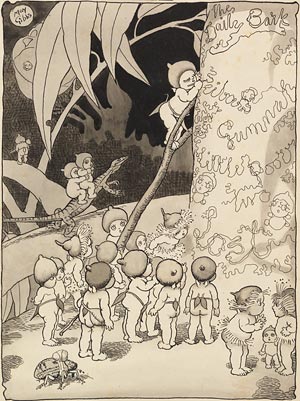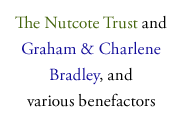Newspaper cartoons
Editor writing his leading article, from Snugglepot & Cuddlepie, by May Gibbs.
Ink & wash. PXD 304/2/123
The 1920s was a prolific and prosperous period for May Gibbs as a syndicated newspaper cartoonist and columnist. At the time, children’s comic strips were becoming popular with titles such as Ginger Meggs and Fatty Finn.
In 1924 Gibbs was the first woman to join the ranks of Australia’s cartoonists, with her popular Bib and Bub cartoon strip, which first appeared in the Sunday News on 3 August 1924. Already a household name with her children's books, Gibbs now pursued her newspaper career with vigour.
Bib and Bub was later syndicated to newspapers across Australia and New Zealand, becoming Australia’s longest-running comic strip, continuing until 1967. The cartoons featured topical themes, as well as ideas adapted from her previous works.
> Learn more about May Gibbs' popular Bib and Bub cartoon strip
Gibbs used the pseudonym Stan Cottman for her second cartoon strip, Tiggy Touchwood, which was published by rival newspaper the Sunday Sun from 1925, and also Melbourne's Sunday News Pictorial from 1926. In a departure from her usual gumnut characters, Tiggy was a pipe-smoking pig which proved equally popular with readers. It ceased publication in 1931.
Given the ongoing success of Bib and Bub, the Sunday News expanded their children’s supplement to include further May Gibbs work. Gumnut Gossip – Extracts from the Daily Bark first appeared in the Sunday News in August 1925. The weekly newspaper column featured short stories and illustrations of life in Gumnut Town, always with a humorous twist or moral for its readers. The Daily Bark was the fictional Gumnut Town newspaper which had first appeared in Snugglepot and Cuddlepie. From 1930 her Gumnut Gossip column was transferred to the Women’s Budget, until it ceased in 1935.
> See a selection of May Gibbs' drawings for Gumnut Gossip, 1925-1935 
Gibbs continued to draw inspiration for her work from the gardens surrounding her home, 'Nutcote', in Neutral Bay. While enthusiasm for her cartoons grew during this period, there was something of a slump in sales of her gumnut books during the Depression years. During this period she also produced merchandise to supplement her income.
> Find more cartoons in the May Gibbs papers, via the Library’s online catalogue ![]()


